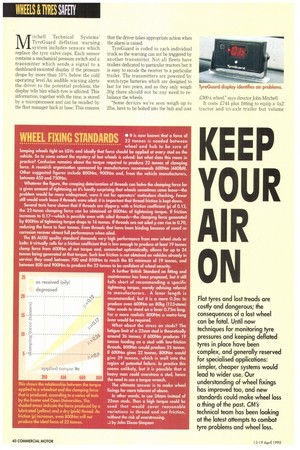WHEEL FIXING STANDARDS
Page 42

If you've noticed an error in this article please click here to report it so we can fix it.
• It is now known that a force of 22 tonnes is needed between wheel and hub to be sure of keeping wheels tight on LGVs and ideally that force should be applied at every stud on the vehicle. So to some extent the mystery of lost wheels is solved: but what does this mean in practice? Confusion remains about the torque required to produce 22 tonnes of clamping force. A research organisation sponsored by manufacturers recommends 600Nm (440Ibft). Other suggested figures include 800Nm, 900Nm and, from the vehicle manufacturers, between 450 and 750Nm.
Whatever the figure, the creeping deterioration of threads can halve the clamping force for a given amount of tightening so it's hardly surprising that wheels sometimes come loose—the problem would be more widespread, were it not for operators' meticulous checking. Fewer still would work loose if threads were oiled: it is important that thread friction is kept down.
Several tests have shown that if threads are slippery, with a friction coefficient (p) of 0.12, the 22-tonne clamping force can be obtained at 800Nm of tightening torque. If friction increases to 0.17—which is possible even with oiled threads—the clamping force generated by 800Nm of tightening torque drops to 16 tonnes. If threads are not oiled p can rise to 0.70, reducing the force to four tonnes. Even threads that have been binding because of swarf or corrosion recover almost full performance when oiled.
The BS AU50 quality standard demands very high performance from new wheel studs or bolts: it virtually calls for a friction coefficient that is low enough to produce at least 19 tonnes clamp force from 600Nm of nut torque and, somewhat optimistically, allows for up to 24 tonnes being generated at that torque. Such low friction is not obtained on vehicles already in service: they need between 700 and 850Nm to reach the BS minimum of 19 tonnes, and between 800 and 900Nm to produce the 22 tonnes to be confident of wheel security.
WHEEL FIXING STANDARDS
A further British Standard on fitting and maintenance has been proposed, but it still falls short of recommending a specific tightening torque, merely advising referral to manufacturers. A lever length is recommended, but it is a mere 0.5m: to produce even 600Nm an 80kg (125-stone) fitter needs to stand on a lever 0.75m long. For a more realistic 800Nm a metre-long lever would be required.
What about the stress on studs? The fatigue limit of a 22mm stud is theoretically around 26 tonnes; if 600Nm produces 19 tonnes loading on a stud with low-friction threads, 800Nm would produce 25 tonnes. If 600Nm gives 22 tonnes, 800Nm would give 29 tonnes, which is well into the region of potential failure. In practice this seems unlikely, but it is possible that a heavy man could overstress a stud, hence the need to use a torque wrench.
The ultimate answer is to make wheel fixings far more tolerant of abuse.
In other words, to use 24mm instead of 22mm studs. Then a high torque could be used that would cover reasonable variations in thread and nut friction, without the risk of overstressing.
J by John Dixon-Simpson
































































































